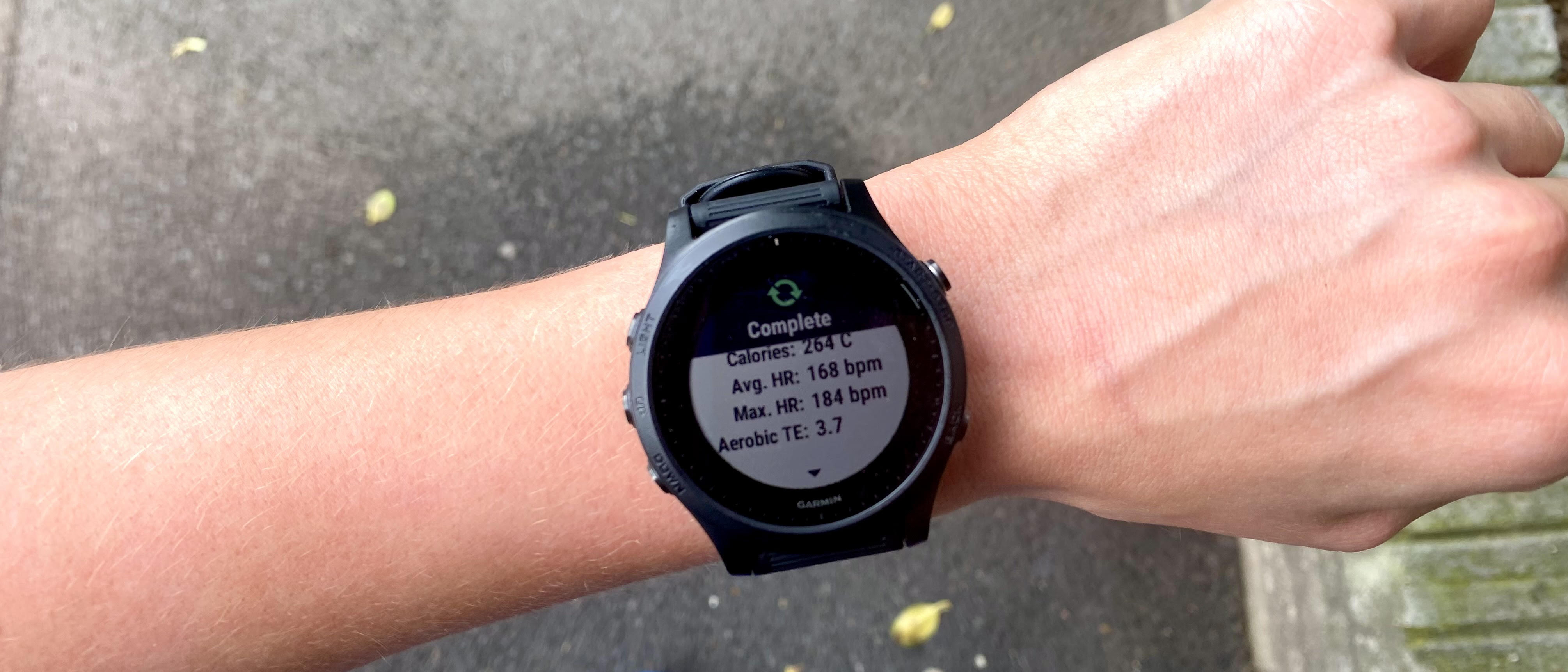Live Science Verdict
The Garmin Forerunner 945 is a pricey but high-performing multisport watch that offers reliable battery life, generous sport tracking options, and thorough health monitoring packed into a lightweight fitness tracker.
Pros
- +
Excellent battery life
- +
Lightweight
- +
Feature-packed
Cons
- -
Expensive
- -
Bulky on slimmer wrists
- -
Unlikely you will use all the features included
Why you can trust Live Science
Any dedicated multisport athlete out there such as triathletes or running junkies will lap up the rich selection of features available with the Garmin Forerunner 945. It’s packed with health and performance monitoring features that have been crafted into a lightweight design, so you don’t need to worry about this fitness tracker weighing you down during your training or races.
My first ever running watch that I purchased back in my days of running as a student was the Garmin Forerunner 735XT, so I was intrigued to take the Forerunner 945 for a spin and see just what can be expected from this much more up-to-date model and whether it’s a credible entry for our best fitness tracker guide.
Battery: 14 days in smartwatch mode, 36 hours in GPS mode and 10 hours in GPS mode with music
GPS availability: Yes
Water proofing: Yes, 5 ATM
Display type: 1.2" (30.4 mm) diameter, sunlight-visible, transflective memory-in-pixel (MIP)
Heart rate tracker: Yes
Sleep tracker: Yes
While the Forerunner 735XT is a suitable match for any multisport athlete on a tighter budget, after testing the Forerunner 945 I can see why it's worth considering the extra $150. Alongside having the ability to track absolutely everything, including things that don’t involve us moving (such as sleep and stress), a big sell for most of us is battery life. Thanks to Garmin, the Forerunner 945 boasts longer battery life in general mode and GPS mode. The tracker offers map routing in full color and there are 30 different sport modes to track your training with.
You can even store up to 1000 songs directly on the tracker. With a built-in pulse oximeter, you can track your blood oxygen levels and the Forerunner 945 upgraded optical heart monitor means you can track your heart rate during swimming activities as well. You can make use of the barometer to keep tabs on any wild changes to the weather and an added bonus for the more adventurous, damage-prone athletes is the damage-resistant glass.
It’s clear that the Garmin Forerunner 945 is one of the best Garmin watches for a reason, but how does it stack up across all the major categories from price to performance? Let’s find out…
Price and release date
The Garmin Forerunner 945 first entered the fitness tracking scene in April 2019 and its face value price then was $599.99/£519.99. However, with newer Garmin models such as the popular selection of Fenix watches available, you’ll quite easily pick the Forerunner 945 up for $399.99/£320.99. This will make a significant dent in your wallet but packs in various Fenix features for a much lesser cost than the likes of a Fenix 7 asking for a whopping $699.99/£599.99.
Design and displays
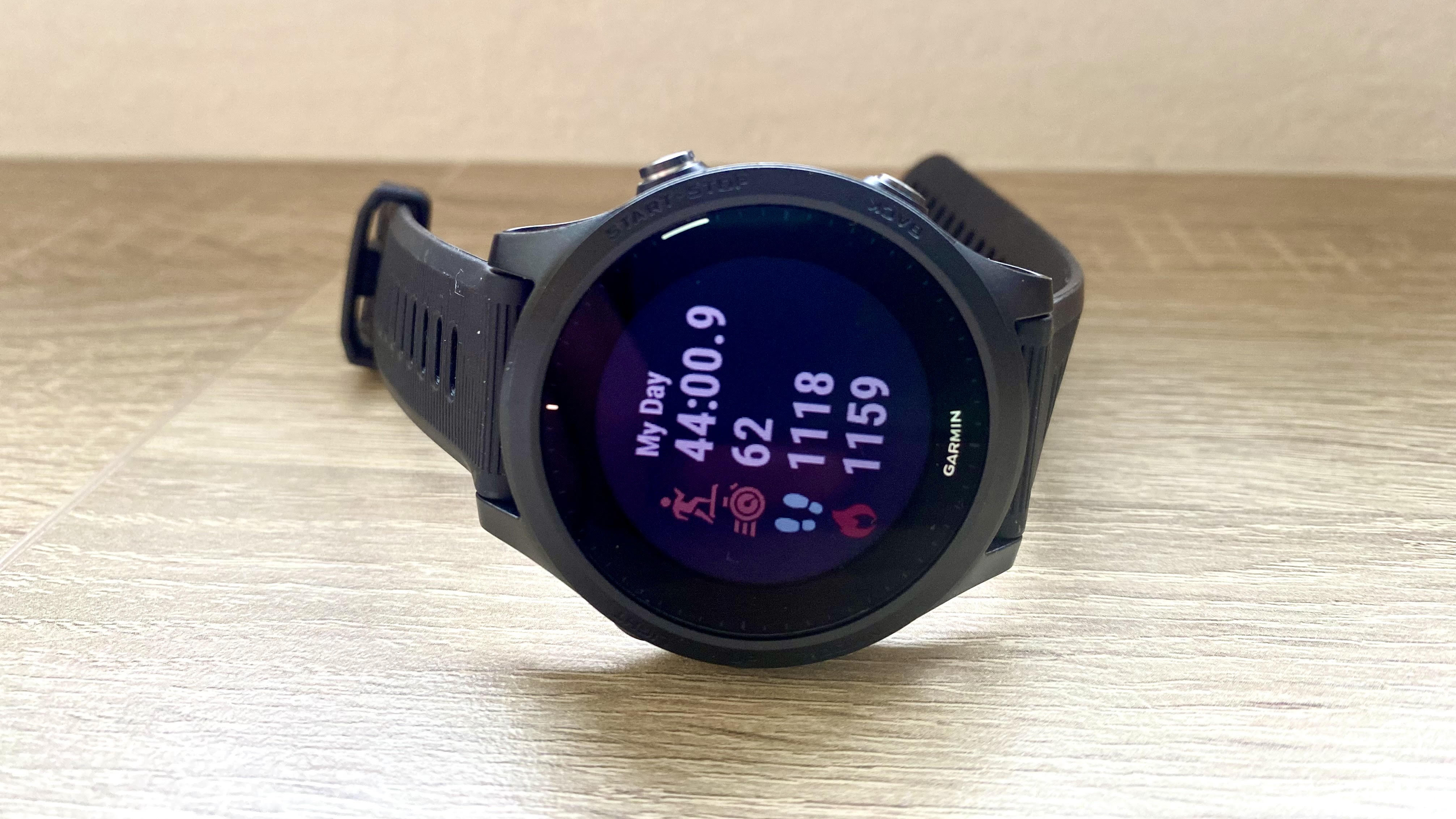
As I said before, the Garmin Forerunner 735XT was the first fitness tracker I bought for myself. This always felt bulky and the very practical plastic look to it reminded me of black lego at times. It was too unattractive for me to want to wear it anywhere outside the gym or off a trail route. Enter the Forerunner 945 and despite the actual watch face looking bulky, it's got a slimmer and more nonchalant aesthetic going on. It weighs in at 50 grams which ain't bad for all this watch packs in. The heart rate monitor juts out on the underside of the watch, but not enough so that you are aware of any discomfort or pressure.
The watch comes in one case size (47 x 47 x 13.7mm) and offers two color options (black with a black strap or black with a blue strap). The limited color option wasn’t an issue for me as some other Garmin models – such as the Garmin Instinct 2 Solar tracker – slightly overwhelms me with the many color variations available. What I will say though is that anyone with naturally slimmer wrists or those who prefer a smaller watch face may wish Garmin had provided more than one size.
The Garmin Forerunner 945 isn’t touchscreen but I don’t see this being an issue for those runners or triathletes looking for accurate sport and health tracking over touch screen facilities. I personally don't enjoy fiddling around a touch screen mid-run with sweaty, fumbly fingers. Instead, there are five buttons located around the side of the watch face, three on the left and a further two situated on the right side of the screen. This is pretty standard for most Garmin fitness trackers.
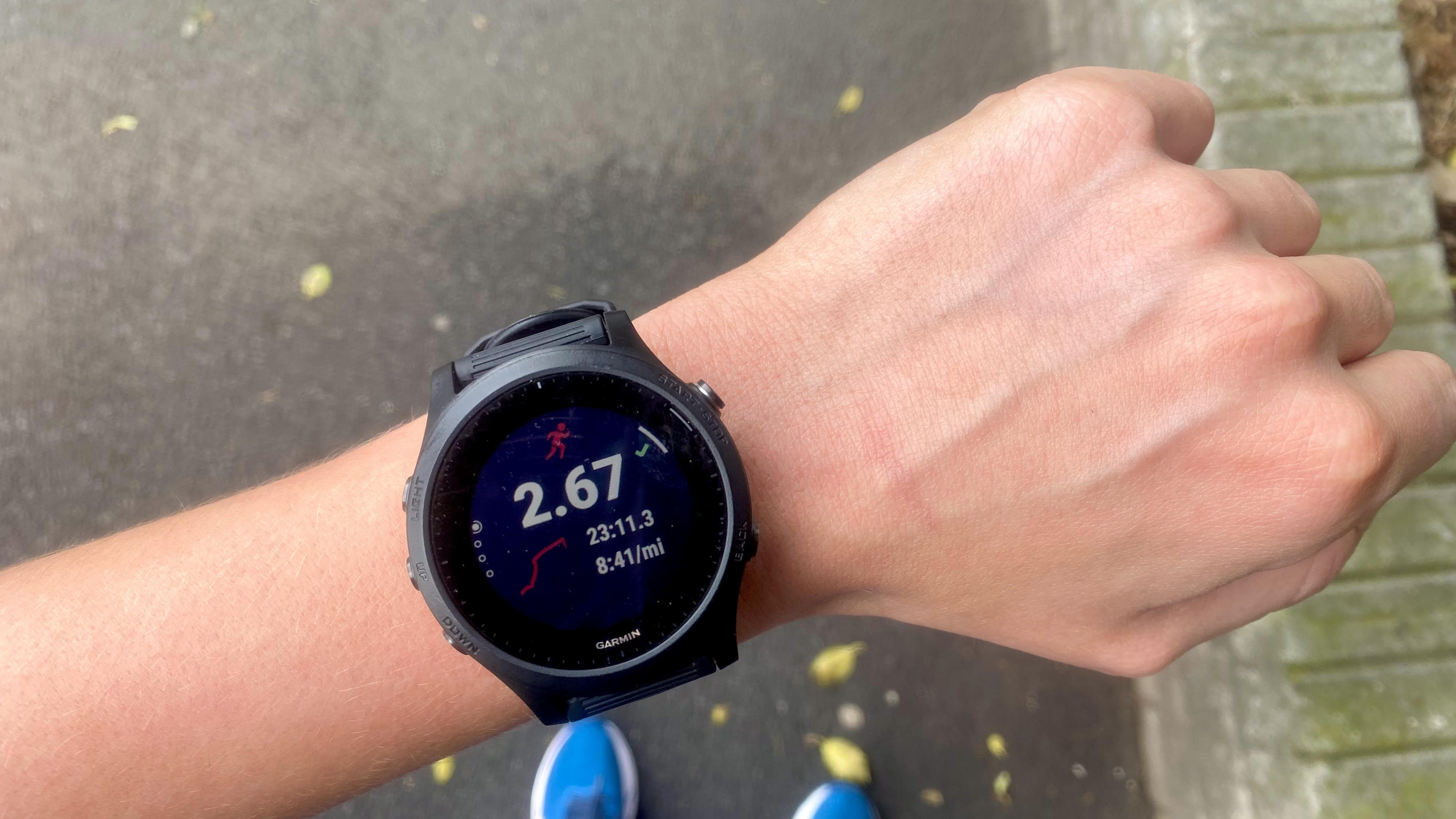
As this fitness tracker is well suited to the outdoorsy runner or keen triathlete, the Forerunner 945 features a transflective display technology to make sure you can view your screen better in sunlight. During testing, I had few problems with screen visibility, even on the sunniest of days. But on the few occasions when I did, such as training in the gym, I simply used the top-left button to toggle on a backlight. Alternatively, during a workout, you can flick your wrist and this same backlight will turn itself on.
The silicone watch strap sits comfortably on the wrist, is sweat friendly, and stays put. The little band that keeps the end of the strap in place did snap on me on my old Forerunner 735XT after some time but the one on the Forerunner 945 seems a little sturdier, but only time will tell. It does feel fairly bulky in bed but anyone who wears a heavier option like the Garmin Fenix 7, which weighs nearly 30 grams more, won’t complain about this.
After having a feel of the Forerunner 945 once it was out of its box and wearing it in various weather conditions plus an indoor and outdoor pool, I have a lot of trust in the durability of this watch. I’ve never smashed the screen of a fitness tracker and I certainly don’t see this happening with the Forerunner 945.
Features
The Garmin Forerunner 945 is no basic step counter for those looking to kickstart a fitness journey. It is a fully fledged advanced fitness tracker, hence why it can track 30 different sports, many of which most users won’t make use of no matter how much of a hybrid athlete you are. During testing I made the most of the very popular Garmin sport modes which were running, biking, and swimming as well as some bonus modes (some of my personal favorite workouts) like Pilates, yoga and strength training.
I’d say the Forerunner 945 reveals important health metrics throughout all of these sports modes, but I gained most from activities that are core to Garmin like running and cycling. If you want to track yoga you need to input the moves via the app prior to training for a more thorough analysis after. I also didn’t find the watch picked up my reps correctly while strength training, but I still gained from seeing my average and max heart rate and calories burned.
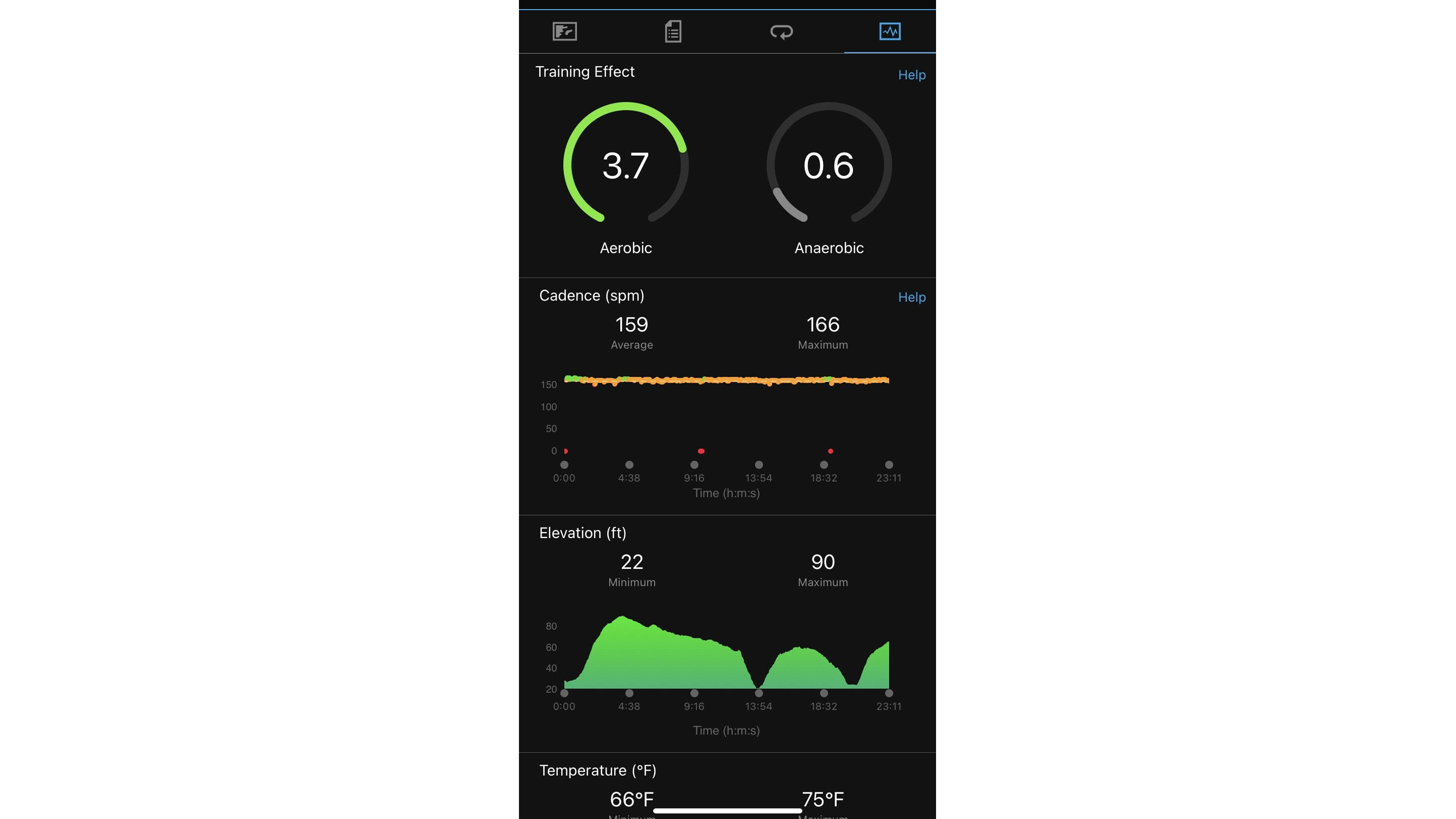
Garmin has included its Elevate v3 heart rate tech inside the Forerunner 945 alongside a pulse oximeter to monitor oxygen saturation. Measuring blood oxygen saturation levels is a handy way to gauge how you are handling increased activity or training levels. The pulse ox sensor can let you know how well you are acclimating to higher altitudes. This wasn’t possible to test in the city but a good feature to have for many hikers, or athletes living in hotter climates, reading this.
A fitness tracker that picks up GPS signals swiftly is a must for anyone who takes their training seriously. While testing the Forerunner 945 I never waited longer than 30 seconds for the GPS signal to pick up and I found the real-time updates on things like pace proved accurate no matter the location or type of run I was completing. I put this to the test, alongside other metrics such as the heart rate monitor, by strapping on the Polar Pacer fitness tracker to my other wrist. There were very small differences in results between the two.
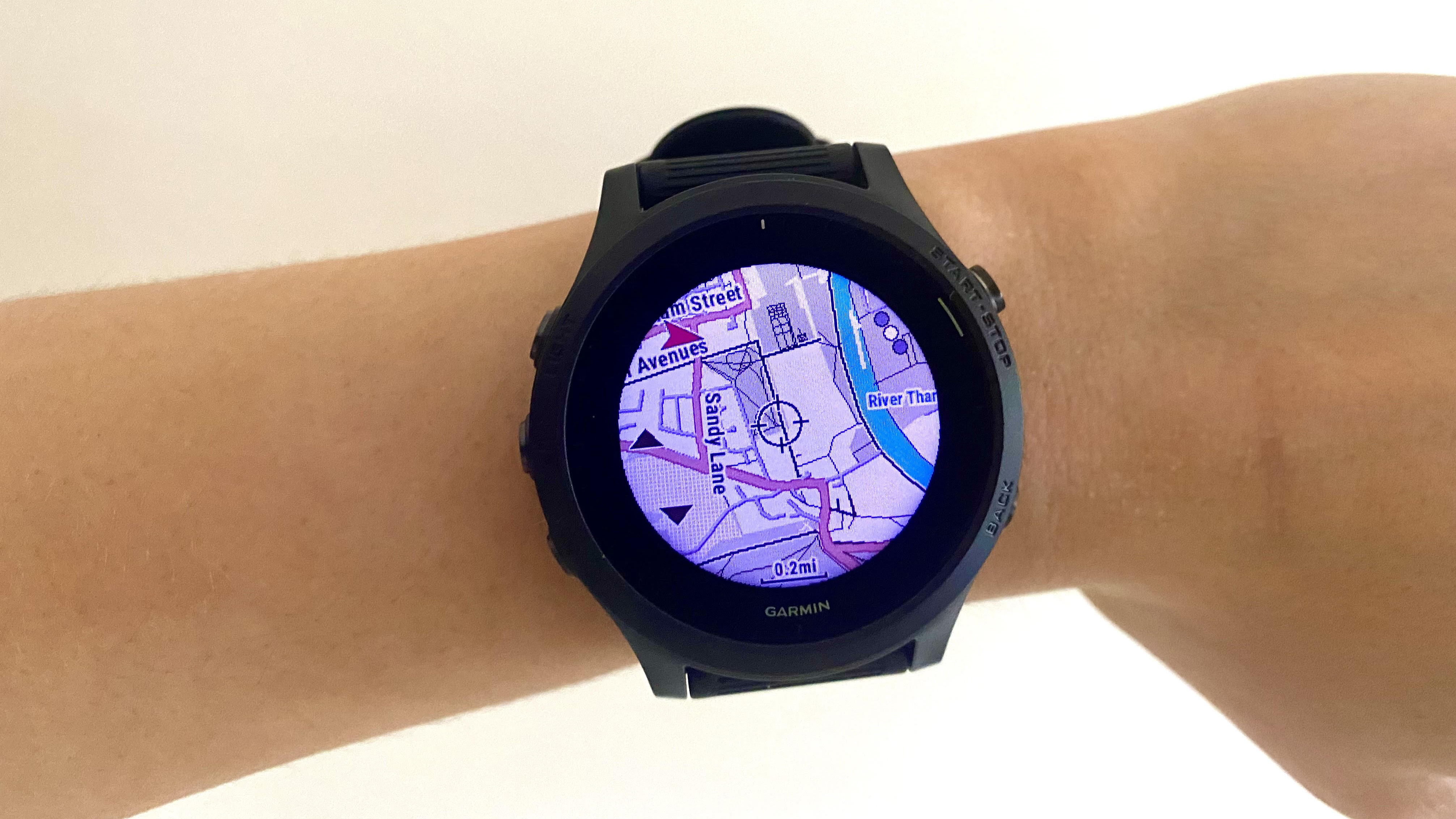
No matter what region you buy a Forerunner 945 from, they will all come with detailed, colored maps of the region they were bought in. The maps include digital elevation data and allow you to navigate around the map by the press of the top right button. Using the map feature you can view navigational points, terrains, and build ‘Round-Trip Courses’. The latter is a great tool for any runners or cyclists in need of Garmin to come up with a route for them, all they need to do is give a distance and desired direction of travel to follow. I found this to be handy as I’m hopeless with navigation in fresh locations and it doesn’t require any internet connection. I also found that I could adjust my pace and effort better when wearing the Forerunner 945 while following a route as the wearable provided information on distance and elevation remaining and details on your climb.
If you’re interested in the smart features that Garmin has added to the Forerunner 945 then music is arguably one of the most appealing upgrades to this watch. You have the option to load your own music library to your tracker (warning: this is quite a long and tedious process) or you can sync it with a supported third-party service. For example, if you own a subscription with Spotify or Deezer you can download offline playlists to the watch via the Garmin Connect app. This meant I was able to listen to music or a podcast out on a run without carrying my phone. If you’re like me and worry about leaving your phone at home while training in case of emergencies, Garmin has added Assistant and Incident Detection to the watch. When you first set up the watch you can add three contacts who will be alerted via text and email if you have a fall whilst out on a run or cycle. The feature can also be activated by yourself by holding down the backlight button.
Garmin Pay is another smart feature available with the Forerunner 945. However, until Garmin makes this compatible with more UK banks, I (and I’m sure many other UK residents) won’t benefit from this feature. Using the Connect IQ store you can download new watch faces and apps to personalize your tracker. I didn’t find many worthwhile apps available to download and this is where an actual smartwatch would be better for those less interested in receiving more advanced performance metrics and more into smart features.
With the addition of a PulseOx sensor to the Forerunner 945, you can set your device to track your blood oxygen saturation as you sleep. Perhaps if Garmin continues to develop this feature, one day you may be able to detect sleep disorders such as sleep apnea but as of now the Forerunner 945 just breaks down your sleep into light, deep, and REM sleep and shares a graph of your movement in bed. I found the watch often overestimated my sleep, thinking I was asleep while reading or watching TV before bed. Fitness tracker brands like Polar offer more in-depth details on sleep quality via their watches. They break down your sleep score and identify which areas of your daily routine could be interfering with a good night’s sleep and where things might need adjusting.
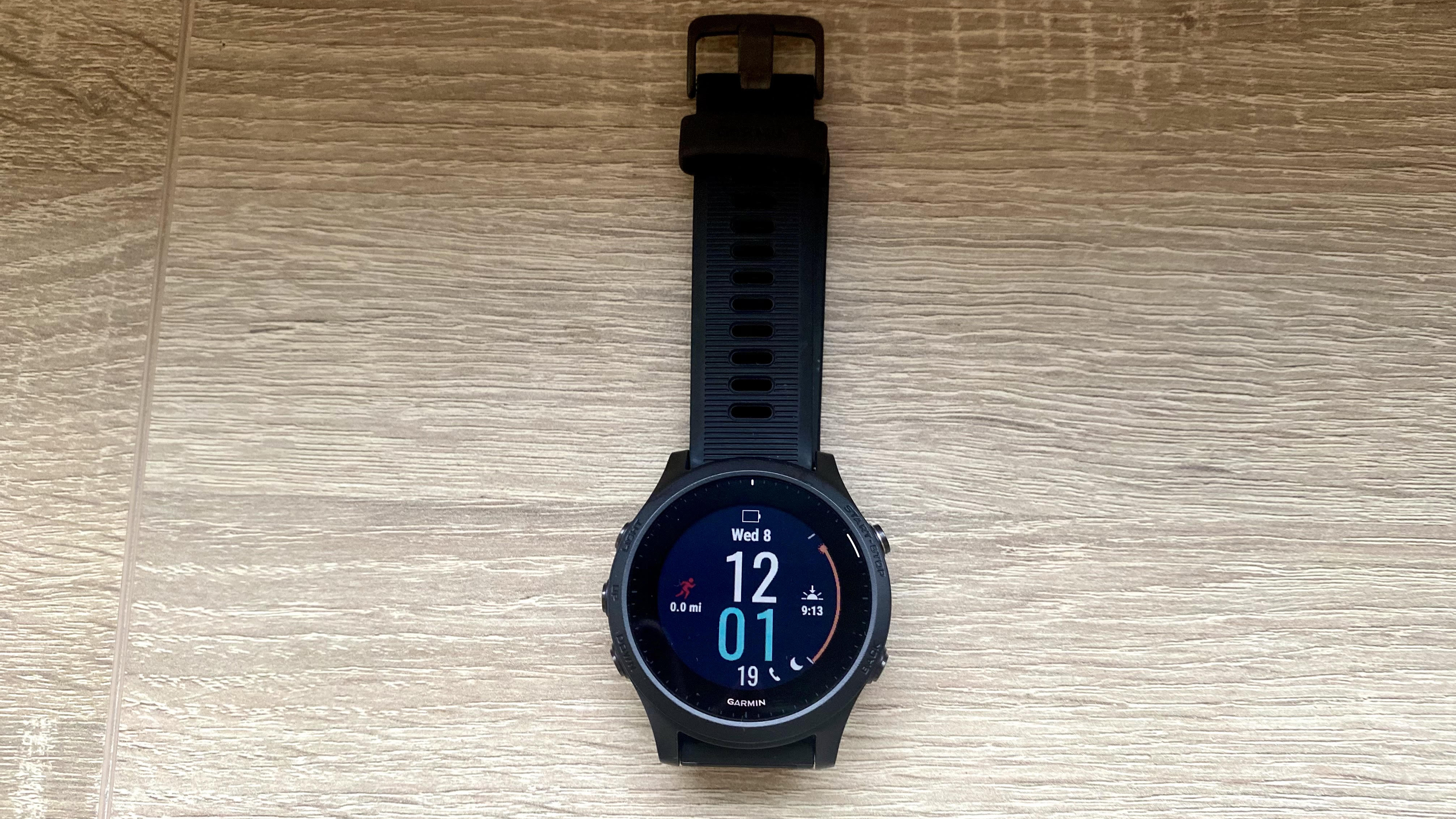
Performance
Nobody wants to leave the house for a run or cycle and see the dreaded image of a low battery bar on their watch. Some Garmin fitness trackers offer unreal battery life such as the Garmin Instinct 2S, which can charge via sun-rays. Fortunately, I had no hiccups with the Forerunner 945 and that’s with regularly listening to music while working out and using GPS during runs. I ended up charging around every three to four days while using these functions and without music, I didn’t find myself charging the watch till around eleven days on full charge. As I live in London, the PulseOx sensor isn't much use to me being far from any significant altitudes but this will probably drain a decent amount of battery if used regularly.
Overall, the optical heart rate tracking did not disappoint across the various runs I completed while testing the Forerunner 945. As I said before, my average heart rate was nearly identical to the reading of my Polar Pacer fitness tracker on my other wrist. But if you do prefer ultimate precision during training then it’s a good idea to buy yourself a chest strap (like the Garmin HRM Run or HRM Pro heart rate strap) as well to ensure your heart rate readings are as accurate as possible.
Pretty much all Garmin fitness trackers measure VO2 max, your VO2 max reveals how effectively your heart and veins forward blood to your muscles and the rest of your body. Therefore, gaining knowledge on your VO2 max can help you measure your fitness levels. Garmin uses this measurement on the Forerunner 945 to offer race predictions. This is something I always think will come in use for beginner runners but I’m yet to be impressed by the predicted race times I’ve been handed from the fitness tracker. I ran a 5K faster than the estimation and a 10K slower than the predicted time. I’m not sure how many advanced athletes will use the race prediction feature anyway.
I mentioned earlier that I was really impressed with how promptly the GPS signal picked up and I don’t have a bad word to say about the speedy GPS chip and global navigation system (GPS GLONASS and Galileo) that Garmin has included in this fitness tracker. My main bugbear with the Forerunner 945, and most other Garmin models I’ve tested, is how inefficient they can be when attempting to count your reps while lifting or exercising in the gym. This is amendable after your workout via the Garmin Connect app, but I never end up getting round to doing this and wish I’d not bothered recording my strength sessions as they rarely reflect what I have actually completed.
Verdict

To put it simply, the Garmin Forerunner 945 is a top-class sports tracking and training analysis fitness tracker. I was pleasantly surprised at how some of its new key features enhanced my training during testing and by the general depth and accuracy provided by the watch when it came to recording core activities like running and biking. Having access to color maps, suggested routes, and live navigation really is a game-changer for getting out and exploring new running or cycling trails without worrying about running out of time or getting lost. The additional smart features, especially the music compatibility, contribute to the enjoyment factor during training and the Forerunner 945 is nice and lightweight to wear, although it could be a little less bulky looking.
Yes, I had some issues with tracking my strength training and things like sleep analysis could be better in this watch, but nothing that interfered with its main performance tracking abilities in the core sports that most users will wear this watch for. I do wonder if it is possible for a user to make use of everything the Forerunner 945 has to offer for such a substantial purchase but on the flipside, you could be splashing out just under a grand for a Garmin Fenix 7X.
If this isn't for you
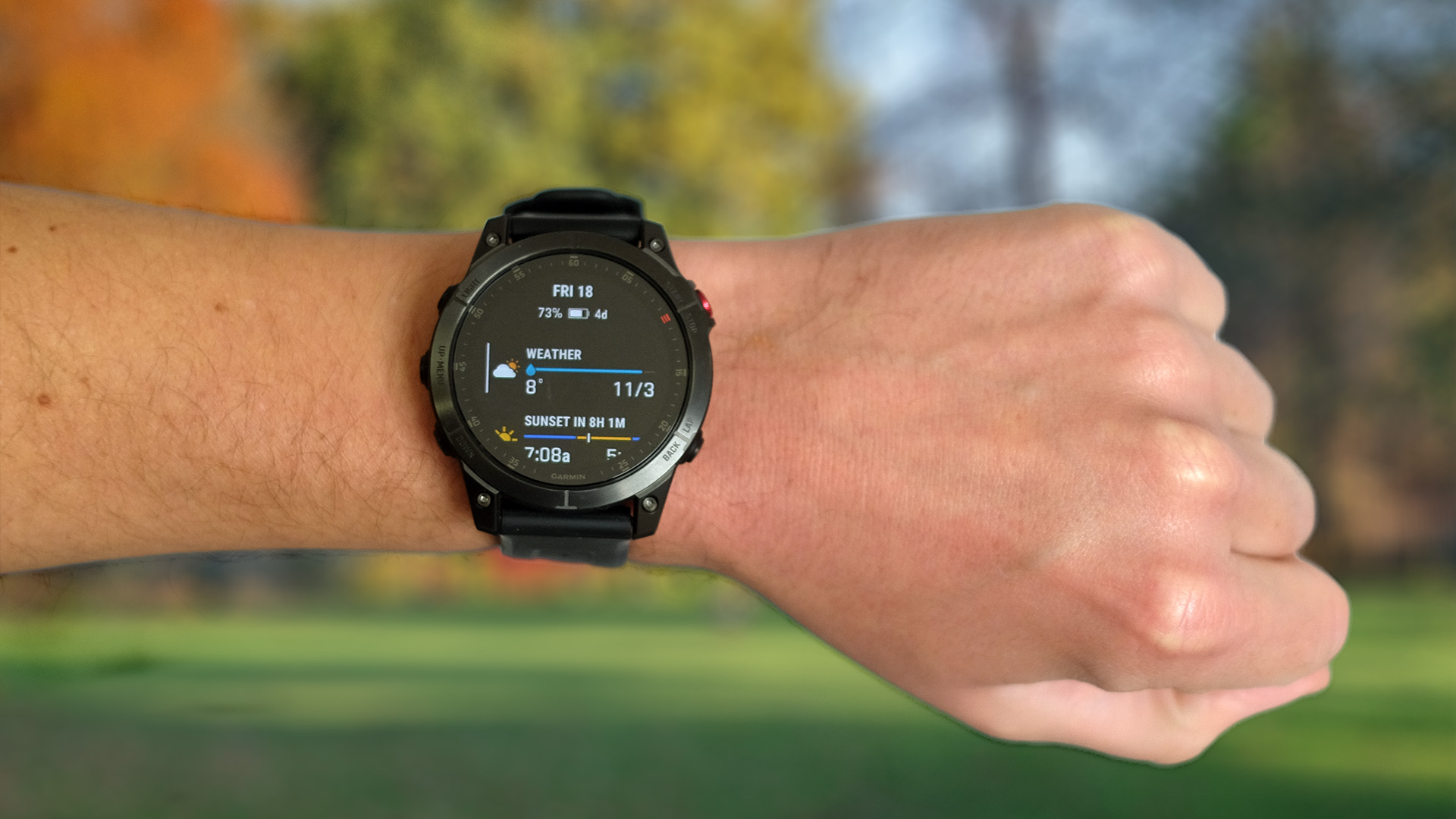
If you like the sound of having a sports specialist fitness tracker but don’t feel like you would use all the features and analysis that the Forerunner 945 has to offer, then you might prefer the Polar Pacer. This is a no-nonsense watch best suited to runners that just need accuracy when it comes to time, pace, distance, laps, GPS, and heart rate tracking. The things it does go above and beyond on are sleep and recovery tools, two things that are essential for becoming a better runner. It’s lighter in weight but the Polar Pacer does cost the same as the Forerunner 945 ($299.99).
On the other hand, if you want to really splurge out on a more plush fitness tracker then the Garmin Epix 2 (above) should be on your radar. This will offer stronger battery life, a greater number of activities available to track, onboard music storage, and contactless payments but on a more sophisticated design, plus its touch screen. This fancier watch comes at a price though, you’ll find yourself parting with $899-$999 if you want one of these on hand for your training.
Jessica is a Staff Writer at our sister site Fit&Well. Her love for keeping fit and fueling her body with healthy and enjoyable food led her to write about all things fitness and health-related. If she isn’t out testing the latest fitness products such as the latest running shoe or yoga mat then she can be found on the Fit&Well news desk writing news and features on the best ways to build strength, active aging, female health, and anything in between. Before then she had a small stint writing in local news, has also written for Runners World UK (print and digital), and gained experience with global content marketing agency, Cedar Communications.
